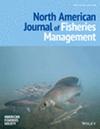Multiscale population demographics and growth responses of trout in the upper Snoqualmie River watershed, Washington
IF 1.4
4区 农林科学
Q3 FISHERIES
引用次数: 0
Abstract
Population demographics of trout were analyzed across multiple spatial scales to evaluate fishery resources in the three forks and main stem of the upper Snoqualmie River, Washington. Physical habitat and trout species compositions, relative abundances, and sizes were assessed through spatially continuous sampling of the watershed. Fish were also sampled at the segment scale (5–20 km) for more detailed but spatially intermediate assessments of species and genetic origin, size at age, and seasonal diet. To evaluate growth conditions during summer months, bioenergetics simulations of consumption by trout were run using summer water temperatures, and growth and diets were sampled at two life stages.We found high variability in longitudinal species compositions, genetic origins, relative abundances, and densities within and among forks. While annual growth generally decreased with distance upstream, summer growth efficiency consistently increased. Areal density estimates of age‐0 recruits in the North and Middle forks generally increased with segment elevation, whereas density of recruits was relatively low in upper elevations of the South Fork, where nonnative Westslope Cutthroat Trout Oncorhynchus clarkii lewisi were most abundant. Abundance of trout varied widely among the forks, and a native metapopulation of Coastal Cutthroat Trout Oncorhynchus clarkii clarkii was the most abundantly distributed species across interconnected main‐stem habitats.Factors affecting population demographics of trout at the riverscape scale included geologic barriers, habitat diversity, and stocking practices, while summer growth was primarily affected by water temperature. Merging riverscape‐ and intermediate‐scale sampling enhanced watershed‐scale inferences made from intermediate sampling while accounting for continuous variability. This design provided a holistic assessment of the trout resources that would not have been possible using either site‐specific sampling or continuous longitudinal surveys and provided a baseline assessment of trout resources in the upper Snoqualmie River watershed for continued management and conservation of the fishery.华盛顿州斯诺夸米河上游流域鳟鱼的多尺度种群人口统计和生长反应
为评价华盛顿州斯诺夸尔米河上游三叉干流的渔业资源,对多空间尺度的鳟鱼种群进行了统计分析。通过空间连续采样,对该流域的自然生境和鳟鱼种类组成、相对丰度和大小进行了评估。还在段尺度(5-20公里)对鱼类进行取样,以对物种和遗传来源、年龄大小和季节性饮食进行更详细但空间上的中间评估。为了评估夏季的生长条件,利用夏季水温对鳟鱼的消耗进行了生物能量学模拟,并对两个生命阶段的生长和饮食进行了采样。我们发现物种的纵向组成、遗传起源、相对丰度以及分叉内部和分叉之间的密度具有很高的可变性。随着上游距离的增加,年生长量普遍降低,而夏季生长效率持续提高。在北部和中部分叉区,年龄为0岁的新成员的面密度估计通常随着段海拔的升高而增加,而在南部分叉区,非本地西坡克氏割喉鳟鱼最丰富的高海拔地区,新成员的密度相对较低。鳟鱼的丰度在不同的分叉区有很大的差异,在相互联系的主干生境中,克拉氏切喉鳟鱼(Oncorhynchus clarkii clarkii)的本地超种群是分布最丰富的物种。影响河流景观尺度下鳟鱼种群特征的因素包括地质屏障、生境多样性和放养方式,而夏季生长主要受水温的影响。合并河流景观和中尺度采样增强了从中尺度采样得出的流域尺度推断,同时考虑了连续变化。该设计提供了对鳟鱼资源的全面评估,这是使用特定地点采样或连续纵向调查无法实现的,并提供了对斯诺夸尔米河上游流域鳟鱼资源的基线评估,以便继续管理和保护渔业。
本文章由计算机程序翻译,如有差异,请以英文原文为准。
求助全文
约1分钟内获得全文
求助全文
来源期刊
CiteScore
2.60
自引率
18.20%
发文量
118
审稿时长
2 months
期刊介绍:
The North American Journal of Fisheries Management promotes communication among fishery managers with an emphasis on North America, and addresses the maintenance, enhancement, and allocation of fisheries resources. It chronicles the development of practical monitoring and management programs for finfish and exploitable shellfish in marine and freshwater environments.
Contributions relate to the management of fish populations, habitats, and users to protect and enhance fish and fishery resources for societal benefits. Case histories of successes, failures, and effects of fisheries programs help convey practical management experience to others.

 求助内容:
求助内容: 应助结果提醒方式:
应助结果提醒方式:


